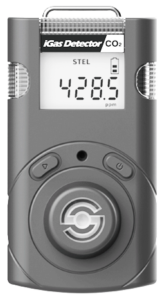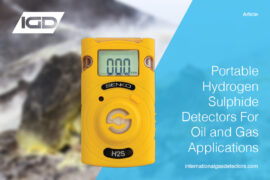CO2 is both an unavoidable byproduct of fermentation and a valuable additive in a range of alcoholic beverages. In this blog post, we explore the reasons that CO2 portable detectors should always be used in breweries.
The Role and Risks of CO2 in Brewing
Yeast cells carry out a dizzying array of biochemical processes during the brewing process. The function of these processes – at least, as far as brewers are concerned – is to convert various sugars into ethanol. An important byproduct of this biological processing is the production of carbon dioxide (CO2).1
Carbon dioxide is, for the most part, the brewer’s friend. Traditionally, carbon dioxide from fermentation will dissolve when kept in a sealed vessel, leading to natural carbonation. In modern breweries, beers are force-carbonated using CO2 which is bought in or recovered from the fermentation process.2,3 In addition, carbon dioxide plays a crucial role in the brewing process by displacing oxygen in that could support the growth of unwanted bacteria in bottles and fermenters.
However, carbon dioxide comes with its own risks. Carbon dioxide acts as an asphyxiant at low concentrations – producing feelings of drowsiness – while at higher concentrations (around 10%) it is acutely toxic, causing symptoms including dizziness, headache, visual and hearing dysfunction, unconsciousness, and eventual suffocation.4,5 For this reason, many countries have legal exposure limits for carbon dioxide in the workplace.6 Use of CO2 portable detectors (as well as fixed detectors) plays a vital role in protecting personnel from these hazards.
In breweries, the large volumes of carbon dioxide produced during fermentation and used during forced carbonation present a real risk to personnel. These risks are compounded by the fact that breweries are typically enclosed spaces, and carbon dioxide is heavier than air: this means that carbon dioxide will tend to accumulate at ground level.
Should I Use CO2 Portable Detectors in my Brewery?
CO2 detectors can be broadly divided into two categories: fixed CO2 detectors and CO2 portable detectors.
Fixed CO2 detectors are semi-permanent systems installed in positions where CO2 hazards are particularly likely to occur. Generally, they sound different levels of alarms when CO2 concentrations exceed predefined levels.
CO2 portable detectors are, as the name suggests, portable. Lightweight and battery-powered, CO2 portable detectors are designed to be carried around by personnel, and will provide a visual, audible, and vibrating alarm when CO2 exposure exceed safe limits.

Brewery Worker with the iGAS CO2 Portable Detector
When it comes to breweries, we always advise using a combination of both CO2 fixed detectors and CO2 portable detectors.
COSHH regulations set explicit exposure limits for hazardous substances including CO2. These are expressed both in terms of Short-Term Exposure Limits (15 minutes) and Time Weighted Averages over periods of 8 hours. While fixed systems are effective for monitoring CO2 concentrations at any given moment, only CO2 portable detectors can monitor personal exposure over 8-hour periods. CO2 personal monitors are therefore an essential piece of PPE that must be used wherever CO2 hazards are prevalent.
In addition to this, providing brewery personnel with CO2 portable monitors helps to cover up the inevitable gaps in a fixed CO2 detection system. CO2 hazards aren’t limited to the main brewery floor: CO2 portable detectors provide much-needed safety for employees entering other spaces such as tanks for cleaning. Sudden release of gas in poorly ventilated spaces means that personnel could be harmed by CO2 before high concentrations are measured by fixed detectors. Fermenter release valves and CO2 canisters all present hazards, and CO2 portable detectors are the only reliable way to defend against them.
Finally, CO2 portable detectors provide a valuable means of detecting and diagnosing problems in breweries. From faulty release valves to equipment problems, unexpected CO2 emissions need to be rapidly detected and dealt with. CO2 portable detectors are the only way of diagnosing and fixing these problems when they arise.
IGD’s CO2 Portable Detector Solution for Breweries
We have over 100 years of experience in gas detection technology, with many decades of specialist knowledge in CO2 detection. This lengthy experience has enabled us to offer the perfect CO2 Portable Detector solution for breweries.
Our partnership with SENKO has given us the opportunity to provide a detectably better CO2 portable detector to all of our clients in form of the iGAS. The iGAS offers the longest lifetime on the market at 14 days, reducing company downtime from needing to recharge the device. Thus, making it the perfect companion in breweries where worker time is essential. This CO2 portable detector utilises a revolutionary NDIR sensor, with an average lifetime of 5-7 years. This massively reduces cost of ownership and upkeep as well as increased convenience, as you can always be sure that your iGAS is working at its best capability.

Pictured: iGAS CO2 Portable Detector. Available from IGD with next day delivery.
Contact Us Today
International gas detectors are a world-leading provider of gas detection systems for all applications. If you’re considering investing in CO2 portable gas detectors, get in touch with us today and we’ll be happy to advise. Being one of the oldest gas detection companies in the world has given us a wealth of experience ensuring you recieve the best support and a detectably better CO2 portable detector.
References and Further Reading
- Bering, C. L. The biochemistry of brewing. J. Chem. Educ. 65, 519 (1988).
- CO2 Recovery System Saves Brewers Money, Puts Bubbles into Beer | NASA Spinoff. https://spinoff.nasa.gov/Spinoff2016/cg_3.html.
- CO2 recovery in beer production | Green Best Practice Community. https://greenbestpractice.jrc.ec.europa.eu/node/245.
- Langford, N. J. Carbon dioxide poisoning. Toxicol Rev 24, 229–235 (2005).
- Permentier, K., Vercammen, S., Soetaert, S. & Schellemans, C. Carbon dioxide poisoning: a literature review of an often forgotten cause of intoxication in the emergency department. Int J Emerg Med 10, 14 (2017).
- Osha. Guidance on Preparing Workplaces for COVID-19.




